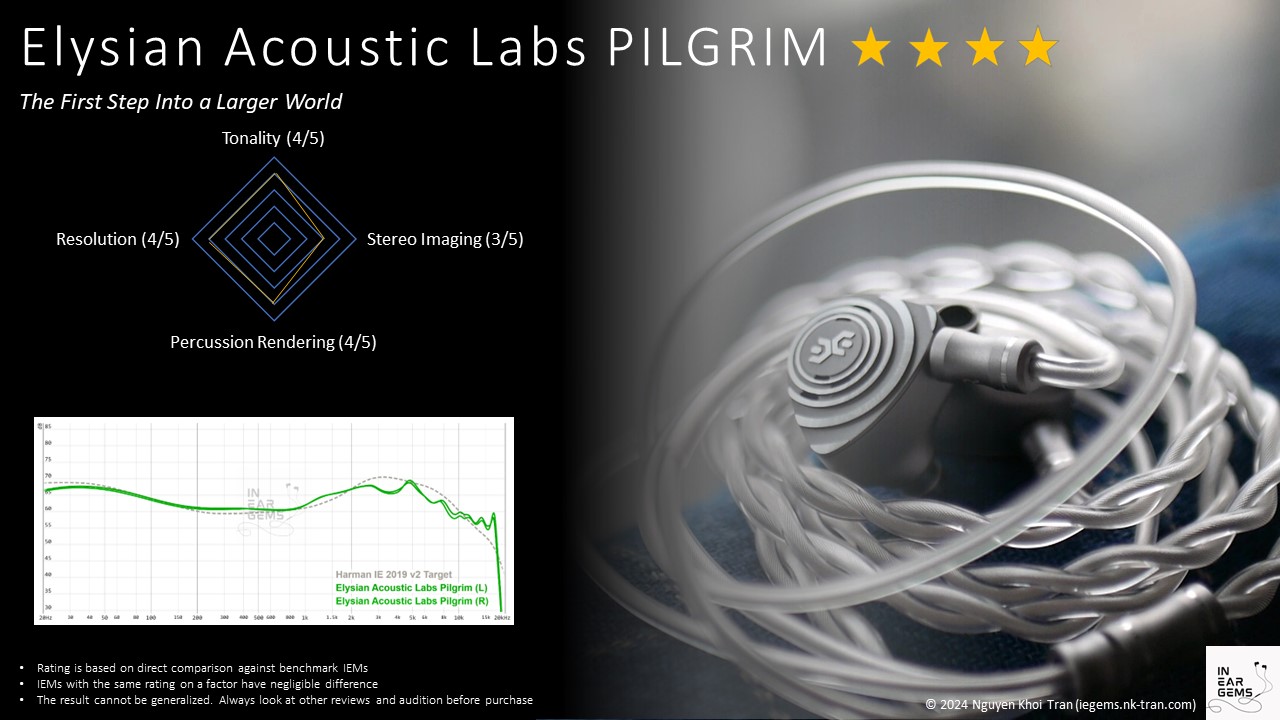Elysian Acoustic Labs Pilgrim - The first step into a larger world
No matter how I look at it, the economy does not look bright when I write this review. This means audiophiles need to tighten their wallets, and manufacturers need to find a way to squeeze through this tightening, generally by releasing more budget-friendly entries. Today, we look at Pilgrim, the latest entry in this incredibly crowded market from the illustrious Eastern boutique Elysian Acoustic Labs.
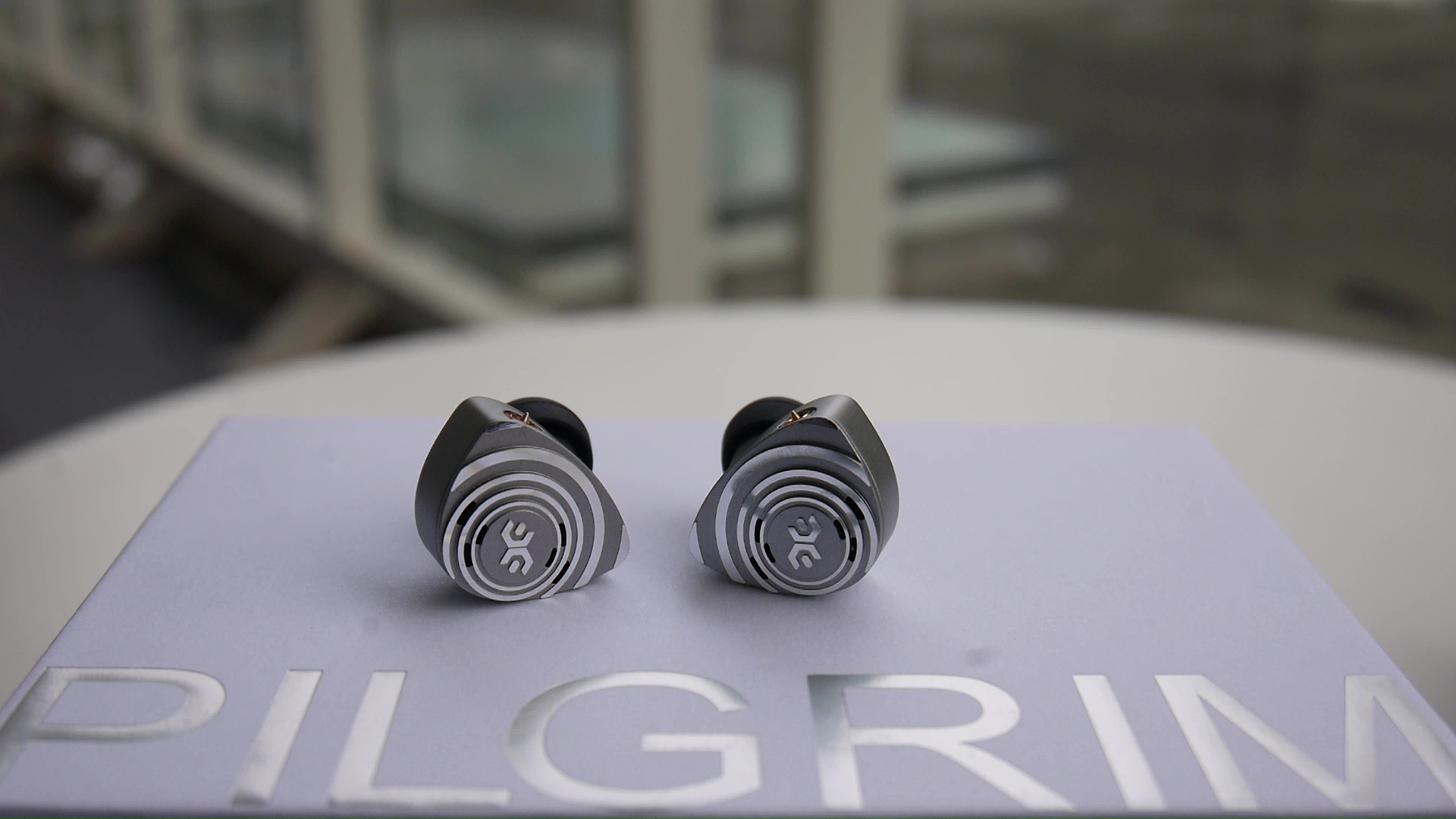
Forewords
- What I look for in an IEM is immersion. I want to feel the orchestra around my head, track individual instruments, and hear all of their textures and details. I’m not picky about tonality, as long as it is not make the orchestra, violin, cellos, and pianos sound wrong.
- I rate IEMs within with a consistent scale from 1 (Poor) to 3 (Good) to 5 (Outstanding). An overall ranking of 3/5 or above is considered positive.
- Ranking list and measurement database are on my IEM review blog.
- The terminology for subjective impressions in this review is based on the Audio Wheel for reproduced sound defined in the technical report ITU-R BS.2399-0
- I purchase the unit for this review at a discount from Hifigo. I have no affiliation with or financial interest in Hifigo and Elysian Acoustic Labs.
- The unit retails for $400 at the time this review was published. Unaffiliated link: Hifigo webstore
General Information
Pilgrim is a hybrid IEM consisting of 1 dynamic driver (DD) and 3 balanced armature drivers (BA). The DD has a diameter of 9.2mm and features a magnesium-aluminium alloy diaphragm and “liquid silicone rubber” surround. This design promises long excursion (flexible surround) while maintaining minimal distortion and agility (metal diaphragm), allowing its bass response to reach as low as 10Hz.
The BA drivers include the Sonion 2300 midrange driver and the Sonion E50 tweeter driver. The incoming signal is split across three types of drivers using a 3-way crossover circuit. All drivers output into a 3D-printed internal chamber, easing production and increasing consistency and quality control.
Non-sound Aspects
.jpg)
.jpg)
.jpg)
.jpg)
.jpg)
.jpg)
.jpg)
.jpg)
.jpg)
.jpg)
.jpg)
Elysian Acoustic Labs is well known for its theatrical packaging, and it’s good to see that trend continue with Pilgrim. The IEM comes in a cubical box, and the unboxing experience is quite elaborate. Like other Elysian IEMs, Pilgrim comes with Spinfit ear tips.
Earpiece design: The earpieces are fully metal. They are not shaped to lock into the outer ears like others, which are shaped like custom IEMs. The faceplate of Pilgrim is quite intricate, with alternative rings of matte and polished metal. In traditional Elysian fashion, Pilgrim has substantial nozzles that are slightly too large for the supplied spin-fit tips.

Fit, comfort, and isolation: After finding the right ear tips to pair with Pilgrim, I found this IEM to be comfortable with average isolation, not unlike other vented IEMs. I did not experience pressure buildup or driver flex in my tests.
Ear tips recommendation: I don’t think the spinfit tips are a good fit for Pilgrim (or most Elysian IEMs). Like most IEMs with strong treble response, choosing ear tips is crucial. Pilgrim works best with ear tips that push the nozzles deeper into the ear canal to avoid unwanted treble peaks. My top choices are Tri Clarion and Velvet ear tips at the right size so that the ear pieces rest against the concha of my ears. In this configuration, I have no problem with the tonal brightness of the treble of Pilgrim.
Sonic Performance
Testing setup:
- Sources: iBasso DX300, L&P W4
- Cable: Stock 4.4mm cable
- Ear tips: Tri Clarion medium
The subjective impression is captured based on the Sound Wheel below.
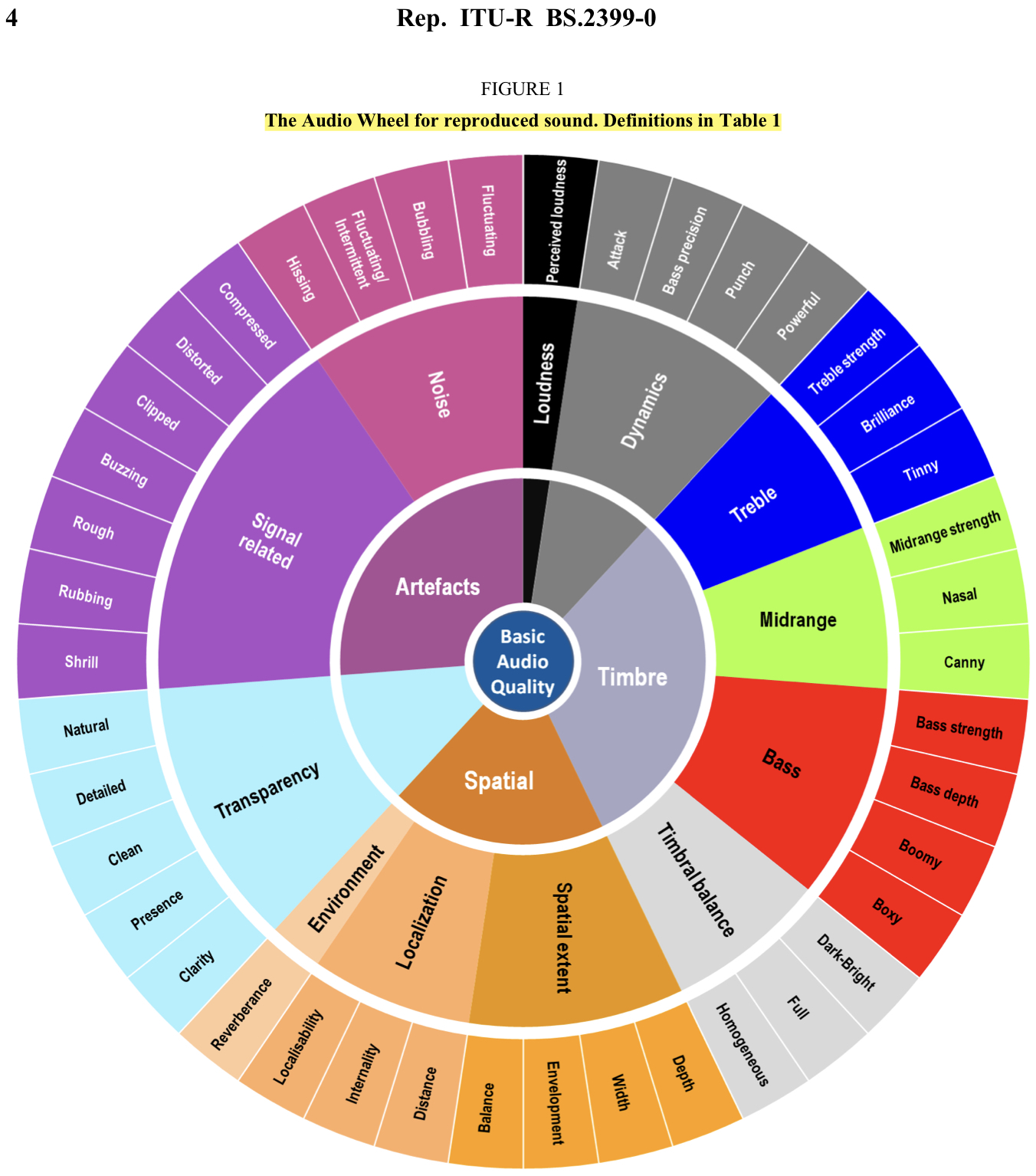
Timbre: Figure shows the frequency response of Pilgrim against the Harman in-ear target. Measurements were done with an IEC-711-compliant coupler and might only be compared with other measurements from this same coupler. Above 8kHz, the measurement might not be correct. Visit my graph database for more comparisons.
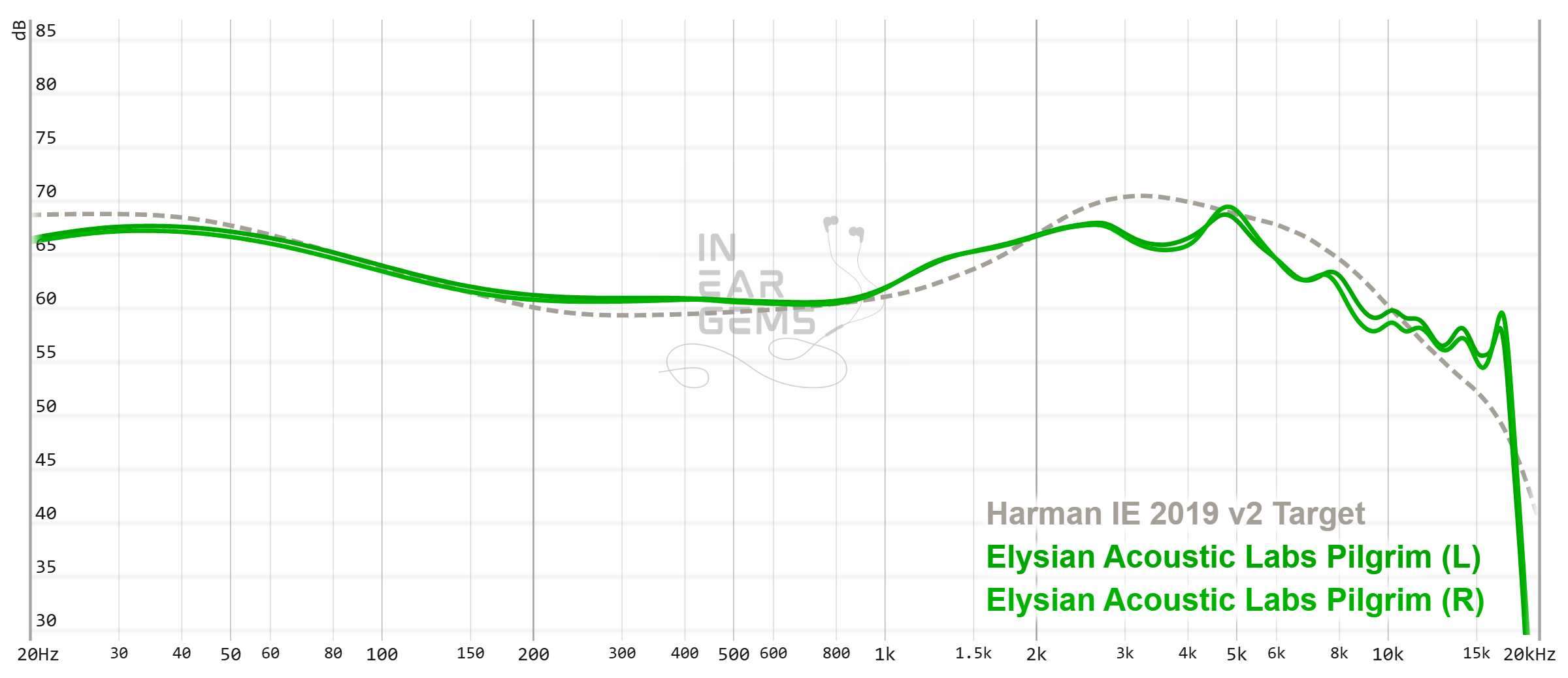
It is helpful to think of an IEM as a filter that highlights or subdues different parts of the incoming audio signal. This effect can be measured objectively by the squiggly lines above, called Frequency Response (FR) graphs, which measure how loud an IEM is at different frequencies from 20Hz (bass) to 20kHz (upper treble). Subjectivity is how your ears and brain interpret the effect of that filter on your music and decide whether it is “enjoyable.” There are some “rules of thumb” when it comes to tonality, but most interesting IEMs usually bend the rules masterfully.
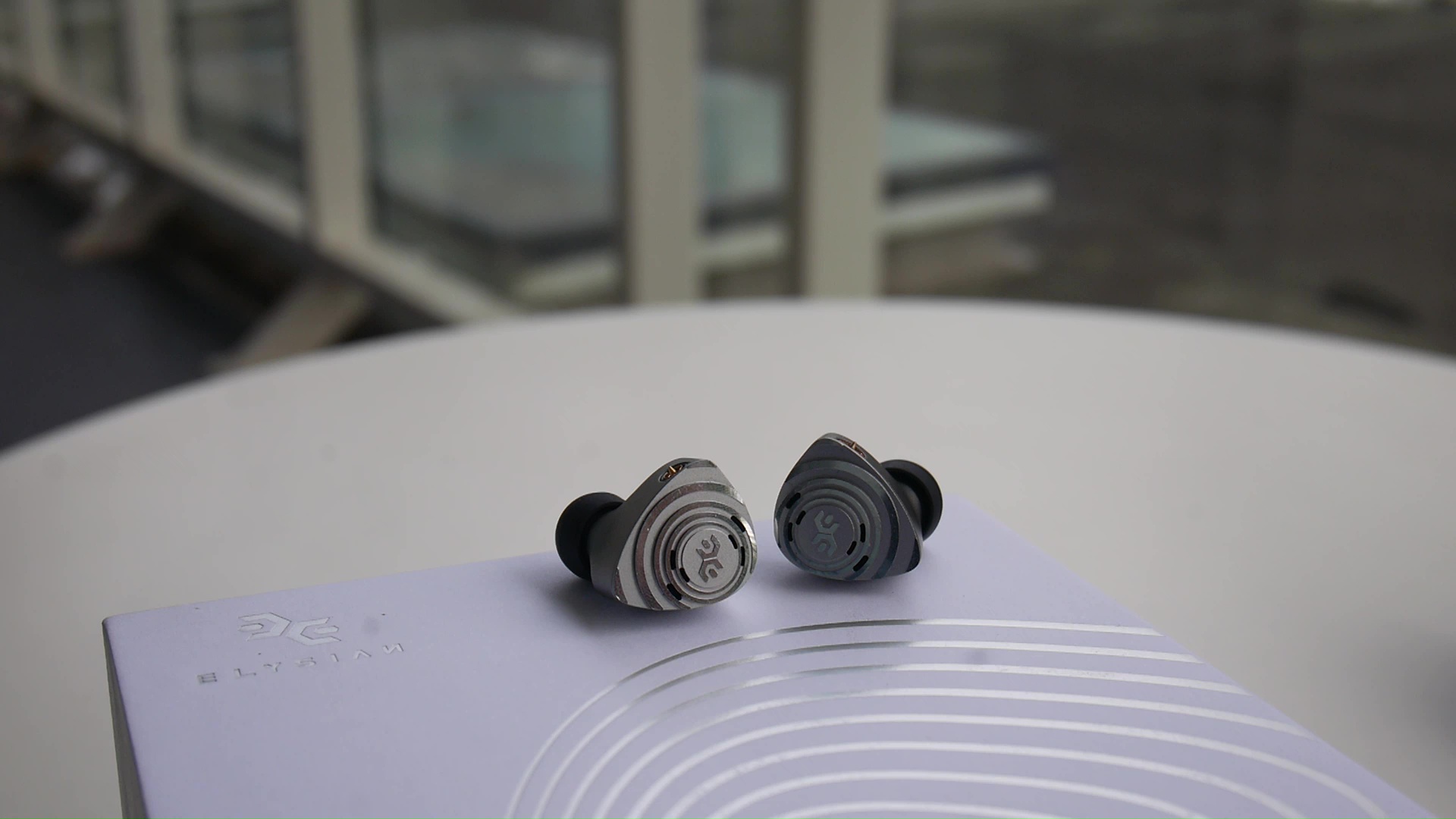
The tonal balance of Pilgrim can be described as slightly neutral-bright with a full and relatively homogeneous frequency response. Let’s unpack this statement. By “slightly” neutral-bright, I mean the Pilgrim mostly achieves a balance in the loudness of bass, midrange, and treble. Still, the treble is a bit more emphasised than the bass. Meanwhile, the midrange sounds perfectly uncoloured. The music reproduction of Pilgrim is “full” because it has a strong extension toward both ends of the frequency spectrum. Pilgrim’s homogeneity or “coherence” is acceptable because it does not have any significant gap across the frequency response (e.g., between bass and midrange). However, there is still a sense of segmentation between bass, mid, and treble. These impressions hold across vocal-centric “weeb music” (Kimi wa Boku ni Nineiru by See-Saw), progressive rock (Playing God by Polyphia), orchestral (Nimbus 2000 from “John Williams: The Berlin Concert”), and epic soundtrack (Victory by Two Steps from Hell). Depending on your choice of ear tips and how you fit the IEM, the treble might be more or less sizzle. I have zero problems with the brightness of Pilgrim, even with “deadly” recordings like Shivers by Ed Sheeran, after opting for Tri Clarion and a deeper fit.
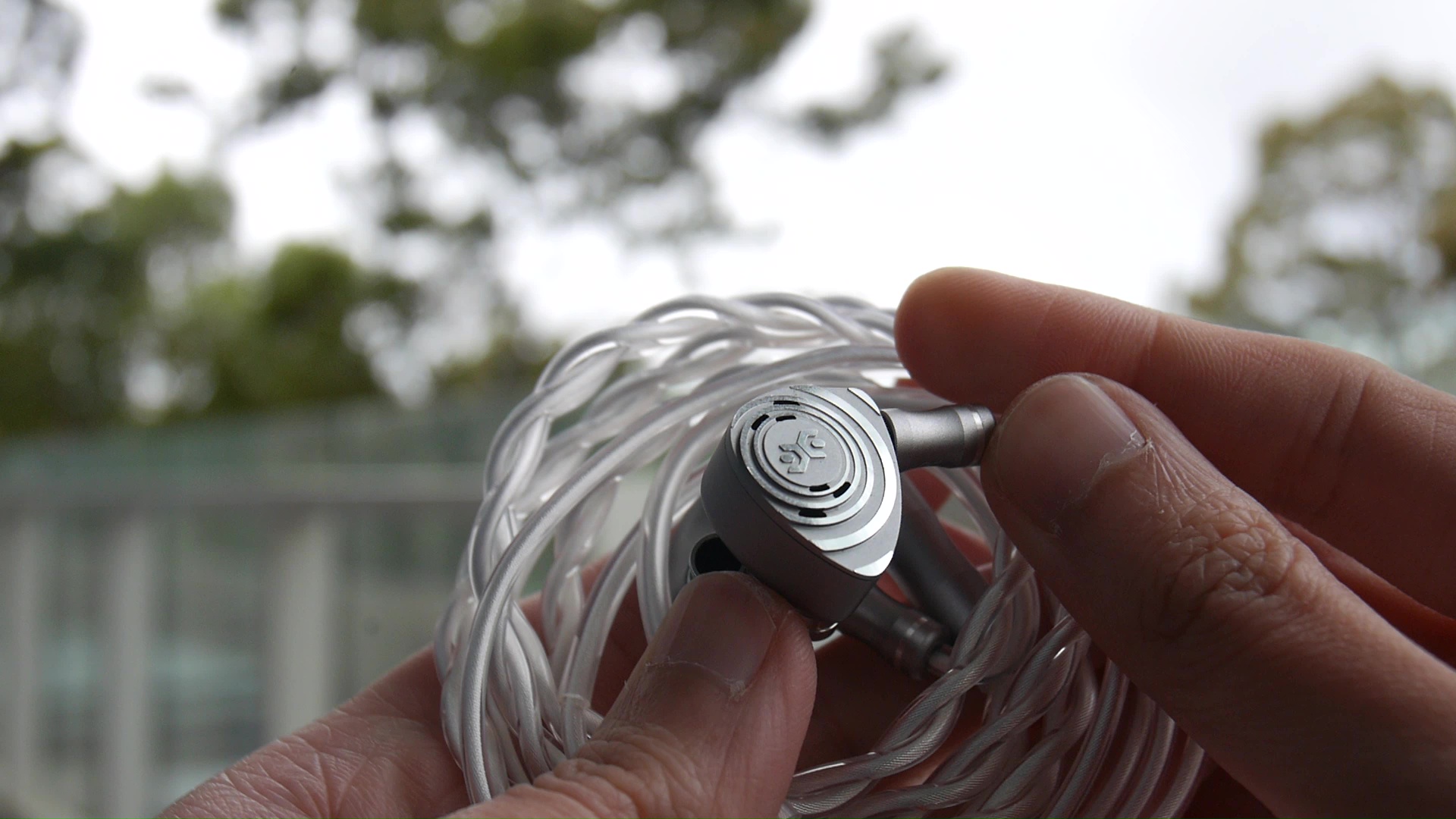
The treble of Pilgrim is slightly above neutral in quantity, with a high level of brilliance. It is highly extended, creating a sense of airiness and openness in the reproduced music. The treble also has strong clarity.
The midrange of Pilgrim is quite loud in the mix, meaning voices and instruments are often pushed forward and present. When testing Pilgrim, I rarely find myself adjusting volume to hear the midrange more clearly.
The bass of Pilgrim keeps up with the midrange in terms of loudness. I didn’t need to increase the volume to hear more bass details or impact. The bass extends deep into the sub-bass, meaning rumble and physical impact can be felt. However, Pilgrim does not exaggerate these qualities. During my tests, I didn’t detect any hint of boominess or boxiness with the bass response. However, I wish that Elysian tunes the Pilgrim with more bass to highlight the available bass quality.
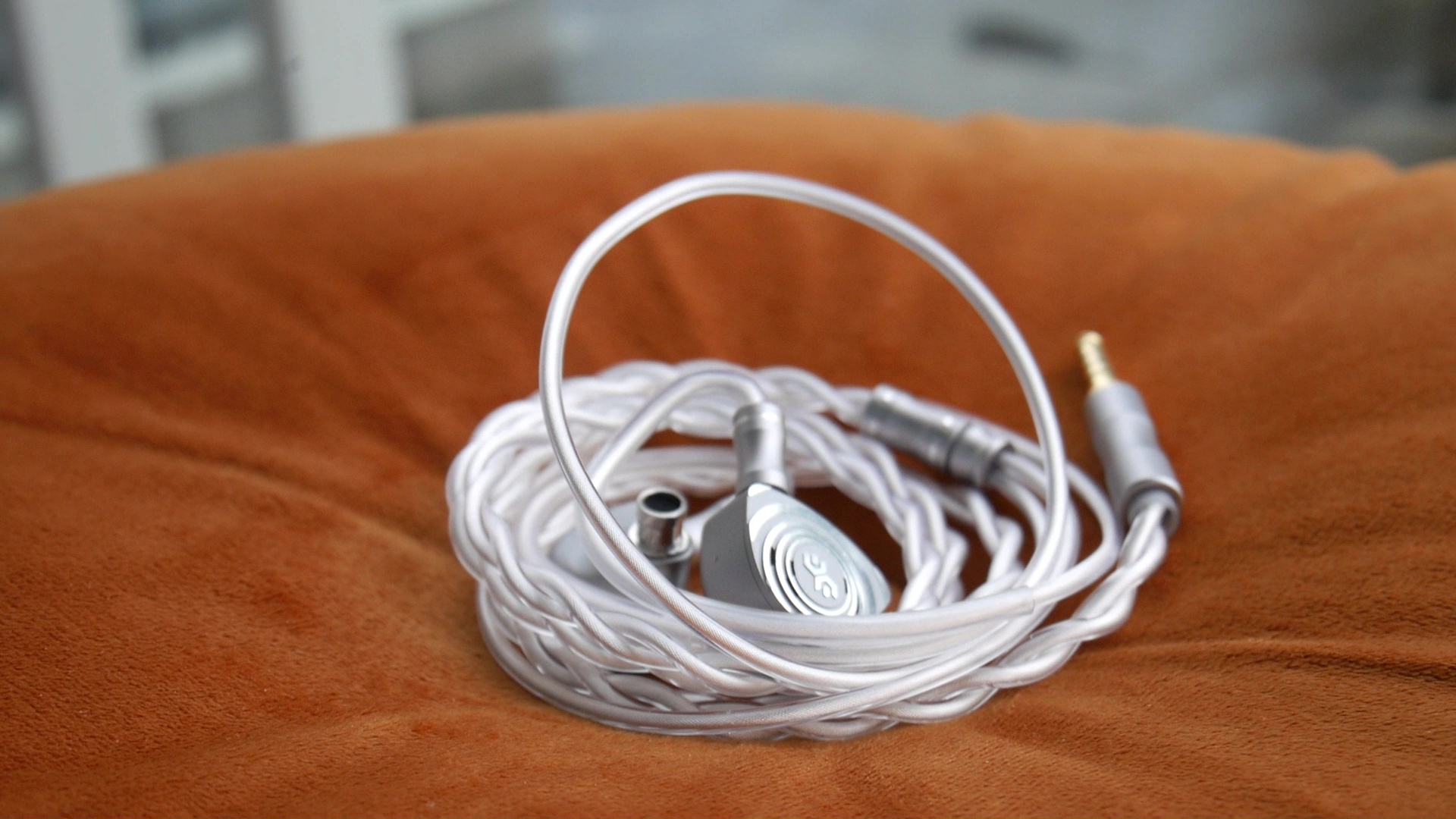
Dynamic: The representation of dynamic is both a strength of Pilgrim and an area where I wish it does a better job. Confusing? Let’s unpack.
An excellent track to highlight the dynamic reproduction of Pilgrim would be “The Way of the Samurai” from the Ghost of Tsushima soundtrack. Every transient (e.g., drum hits, articulation from the strings) is snappy, accurate, and clear. The bass feels precise. Every bass note has a physical sensation as if pressure is pushed against the eardrums. In other words, Pilgrim is a snappy IEM.
However, I wish that Elysian pushes the dynamic of Pilgrim just a touch further, perhaps by raising both the bass and the treble by a few dB. Even though Pilgrim already has a powerful presentation, it left me wanting even more of that snappy, tactile response. This is not an impossible request, as both Pilgrim’s siblings I happen to have for comparison, the Gaea and Annihilator 2023, slam harder in A/B tests.
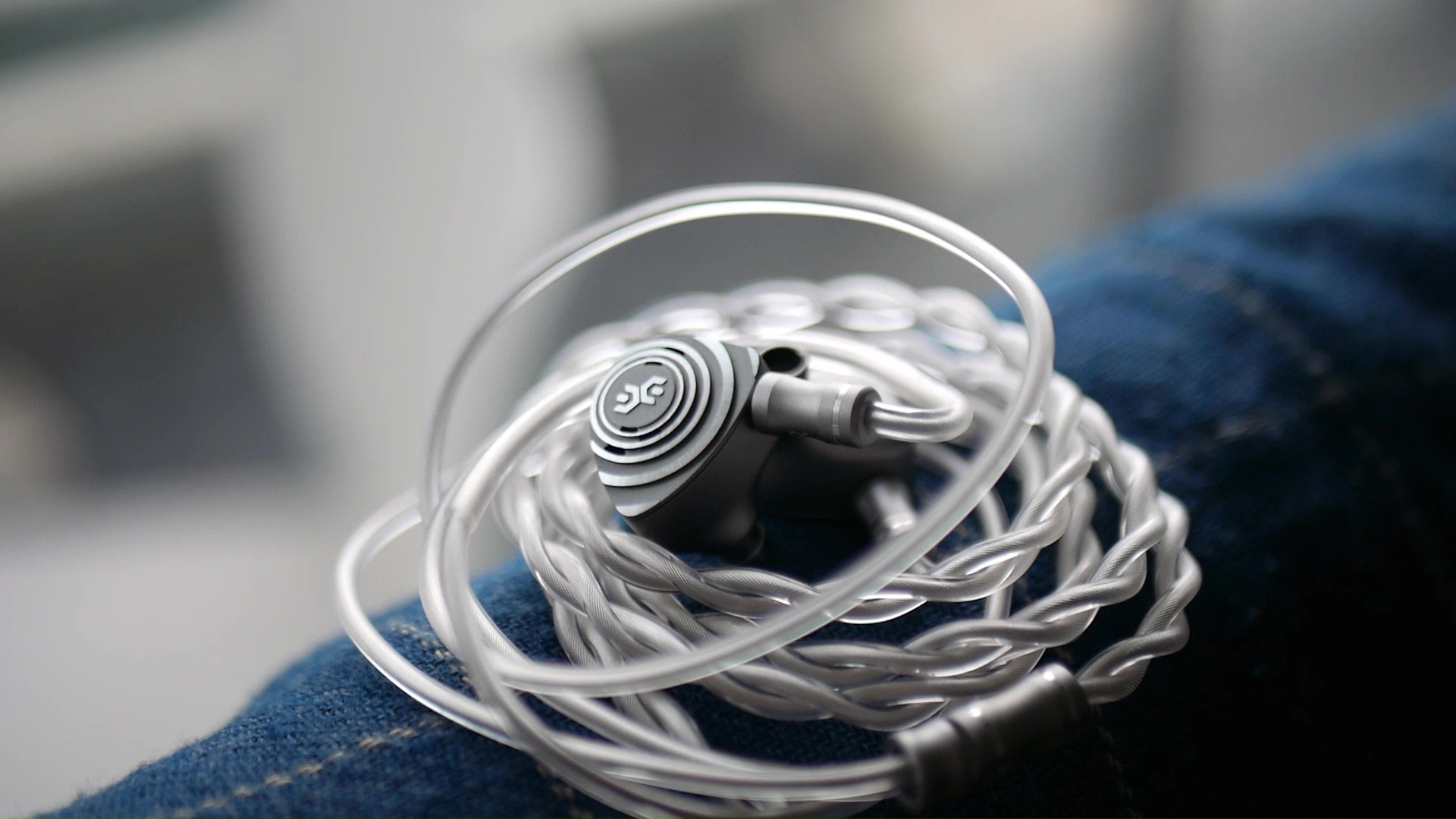
Resolution: To me, “resolution” can be broken down into three components: (1) Sharpness, incisiveness, or “definition” of note attacks (see the figure below). (2) The separation of instruments and vocals, especially when they overlap on the soundstage. (3) The texture and details in the decay side of the notes. The first two give music clarity and make it easy to track individual elements of a mix. The last provides music details and nuances.

The resolution of Pilgrim is quite impressive. This IEM excels in clarity, presence, and cleanness. It means that even with busy tracks like the Ghost of Tsushima soundtracks or the controlled chaos in the “Remember That You Will Die” album by Polyphia, Pilgrim maintains an impressive ability to keep instruments spatially separated on the soundstage whilst retaining the timbral accuracy of each and ensuring that essential parts of the mix are upfront and highlighted. Yes, the clear stereo image of Pilgrim does falter to some degree when I listen closely, especially in comparison with “top of the line” IEMs like its sibling Annihilator 2023. But still, in a vacuum, Pilgrim is a crystal clear IEM.
Pilgrim is also highly competent at detail retrieval. For instance, when I listen to Leonidas Kavakos’s “Bach: Sei Solo” album, I can hear nuances and texture in the violin sound and easily discern the reverberation of the hall where the recordings were made. It also held its own in direct comparison against benchmark IEMs for good detail retrieval in my collection and only truly falters when pitched against the likes of U12T and Annihilator 2023.
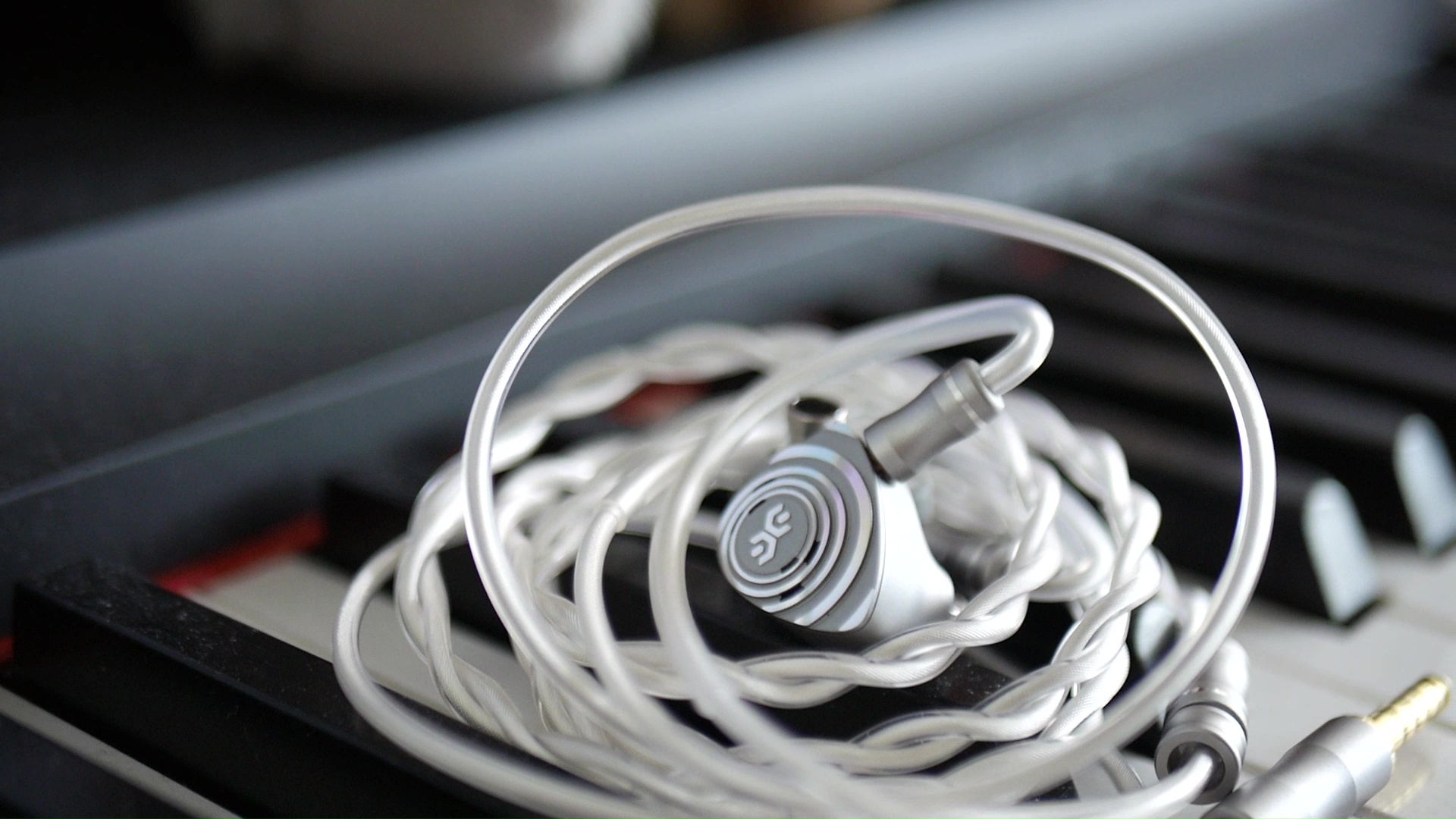
Spatial: Stereo imaging or “soundstage” is a psychoacoustic illusion that different recording elements appear at various locations inside and around your head. Your brain creates based on the cues in the recording, which are enhanced or diminushed by your IEMs, your DAC, and your amplifier. In rare cases, with some specific songs, some IEMs can trick you into thinking that the sound comes from the environment (a.k.a., “holographic”). The figure below shows how I hear and describe soundstage

The spatial reproduction is where I have the most bones to pick with Pilgrim. Precise but lacking immersion is how I would describe the soundstage and imaging of Pilgrim.
First, let’s talk about “spatial extent”, or the shape and size of the soundstage. On the plus side, Pilgrim has excellent width, meaning the left-to-right stretch of the stage is reasonably competent. When sound is pushed all the way to the sides, such as the voice of Kirstin from Pentatonix in “Bohemian Rhapsody”, it can appear outside the ears, hovering over my shoulders. On the other hand, the depth is not great. Simply put, most of the “action” on Pilgrim’s soundstage is condensed on a flat plane, without much contrast between closer and further away sound. As a result, the soundstage of Pilgrim does not create a strong envelopment illusion (i.e., not “wrapping” around the head).
Next, let’s talk about “localisation”: the ability to pinpoint the location and size of audio sources within a soundstage. As I mentioned above, the sense of distance is not a strong suit of Pilgrim due to the way it shapes the soundstage. Similarly to the majority of IEM, sound sources are primarily perceived as coming from inside the head unless they are panned all the way to the sides. Fortunately, the precision of the location is quite good with Pilgrim, meaning it is pretty easy for me to pinpoint the location and size of the sound sources on the soundstage.
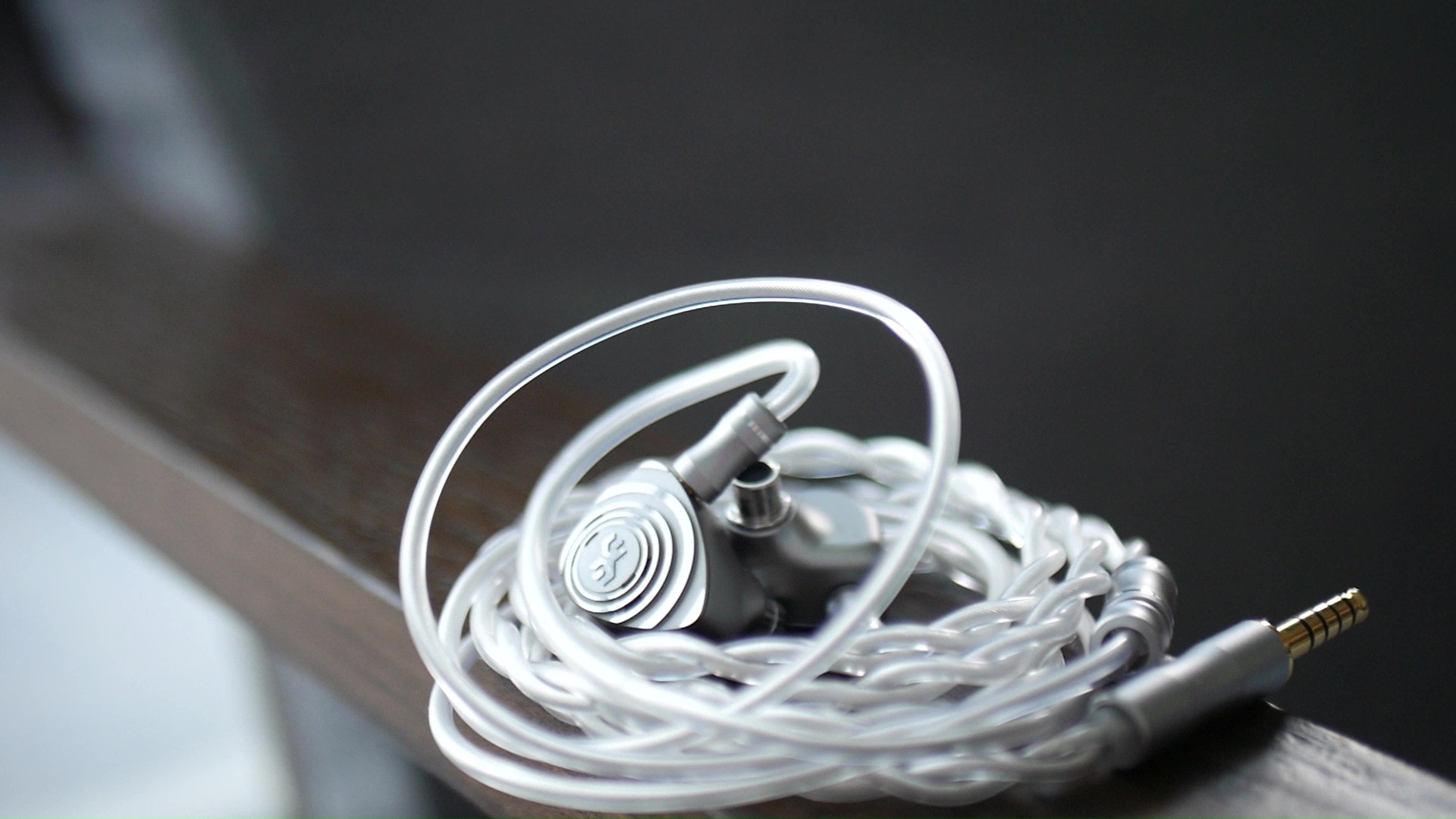
Multimedia usage:
The precise sound localisation of Pilgrim translates to excellent performance in FPS gaming. For example, in CS:GO, it is easy to pinpoint and track the angle and distance of footsteps and gunshots. I’m surprised that Pilgrim’s lack of soundstage depth does not disadvantage pinpointing sounds coming from the front in these games. Action movies also sound good with Pilgrim.
Driveability
.jpg)
Main test track: Playing God - Polyphia
As usual, I started my tests with the humble Apple dongle. My first impression was a congested and condensed soundstage. Moreover, both the bass extension and treble extension suffer. Even though the Apple dongle can provide the voltage, it cannot maintain a current supply that is good enough to drive the Pilgrim well. The sound is not bad, but I cannot recommend this pairing due to the loss of performance.
Switching to a good dongle like the L&P W4, I immediately notice a more spacious soundstage and better sub-bass response. The improvement from W4 to DX300 was not as noticeable. However, the DX300 does change the tonality of Pilgrim slightly, making the midrange warmer and thicker.
For fun, I pair Pilgrim with Topping G5, acting as a pure amplifier for DX300. I hear an even snappier transient response, and the stage has a greater sense of depth and layering. This result suggests that Pilgrim can “scale” with desktop-class setups. I would leave it to readers to explore this path.
Comparisons

Source: L&P W4
Main test track: One Winged Angel - The Danish National Symphony Orchestra
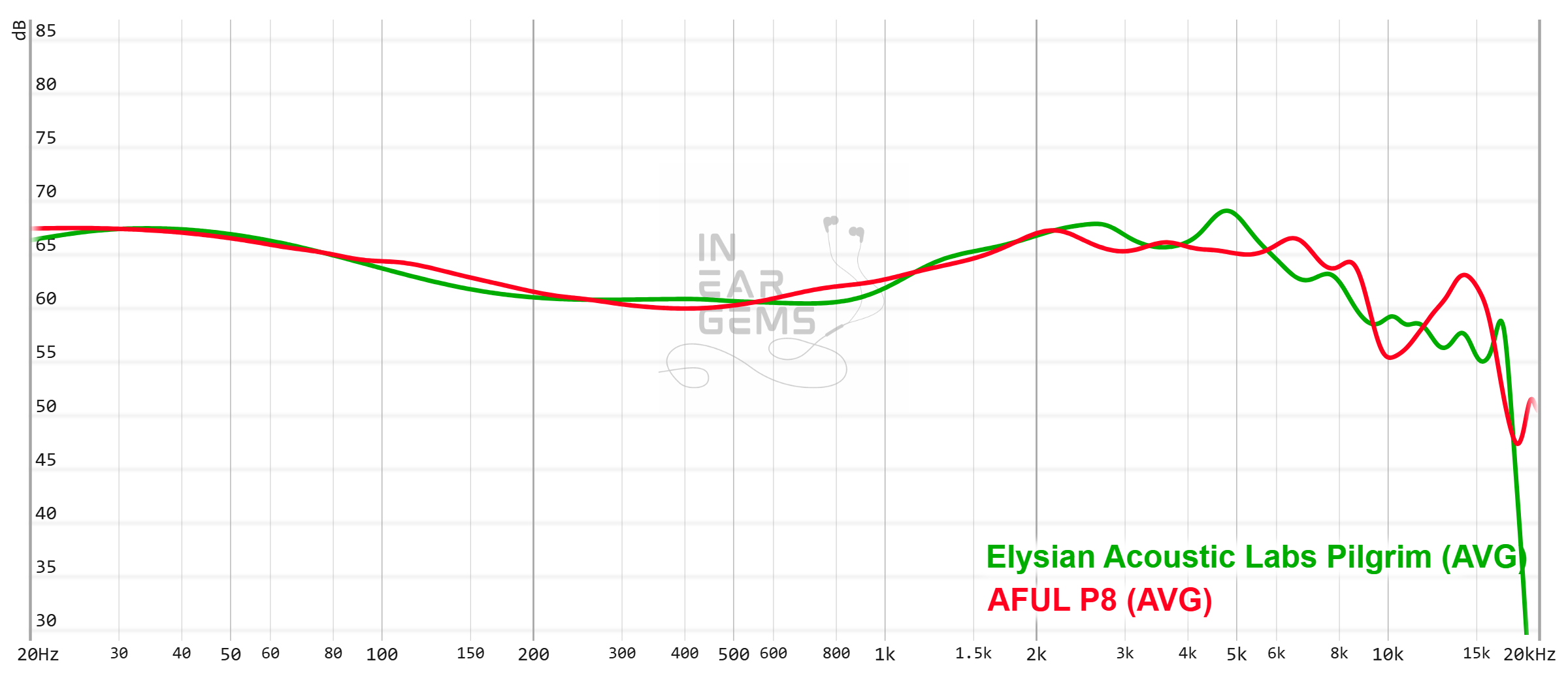
Vs AFUL Performer8: The Performer8 (P8) is one of the overachievers in the “mid-fi” market regarding resolution and imaging precision. In fact, it was one of the first IEMs I tested that could squarely match my benchmark for a “great” level of technical performance in these aspects. Therefore, my first AB test for Pilgrim must definitely be against the P8. My first observation is how these IEMs are tuned so similarly. Both have a “flat” midrange with reserved upper midrange, strong bass extension, and strong treble extension. At the same time, the tonality of these IEMs is also so different to the point that they always make the midrange of the others feel uncanny within the first few seconds of switching from one IEM to the other. This difference is most likely due to how they tune the 1.25kHz region. I prefer the more conventional approach of Pilgrim here.
Regarding resolution and imaging, I spent quite a lot of time switching back and forth, twisting my ears to try to hear the difference. Still, I have to conclude that they are practically identical. Similar note definition, similar instrument separation, similar micro details at the decay of the notes, similar precise imaging, similar shallow soundstage. If I nitpick, I would say Pilgrim has a bit more texture, detail, and extension in the bass region, and the stage of Pilgrim is a bit less “flat” than P8.
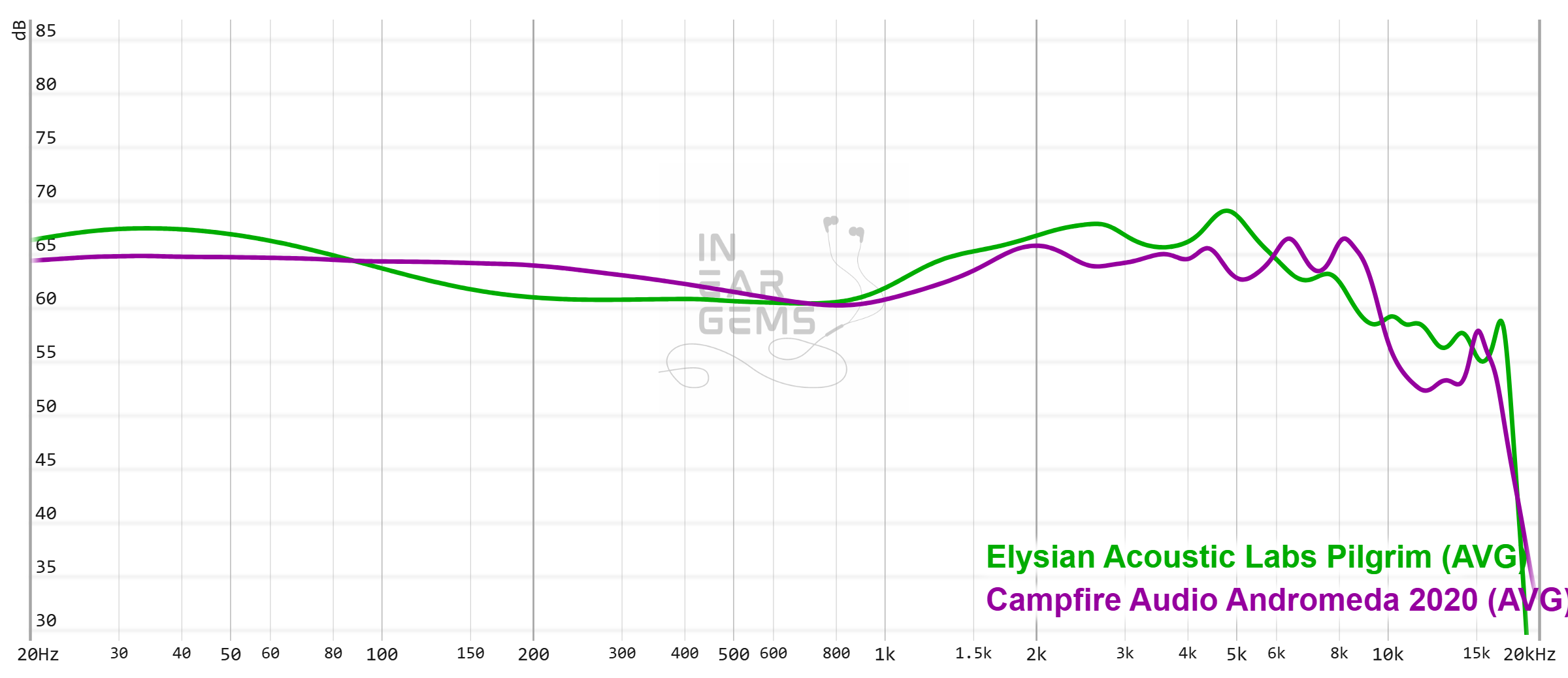
Vs Andromeda 2020: Andromeda 2020 has been and remains to be my benchmark for the “great” level of resolution and staging. How does Pilgrim fare? The first difference is the tonality: the Pilgrim’s midrange is more neutral, whilst Andromeda 2020 is slightly warmer. Moving past the tonality, the following key difference is the bass response. The bass of Pilgrim is simply better, no matter how I look at it. Where Andromeda 2020 beats Pilgrim soundly is the shape of the stage. In back-to-back comparisons, Andromeda 2020 exaggerates the flat stage of Pilgrim. Resolution-wise, the Pilgrim emphasises note attacks more, but overall, they separate instruments and resolve detail practically at the same level.
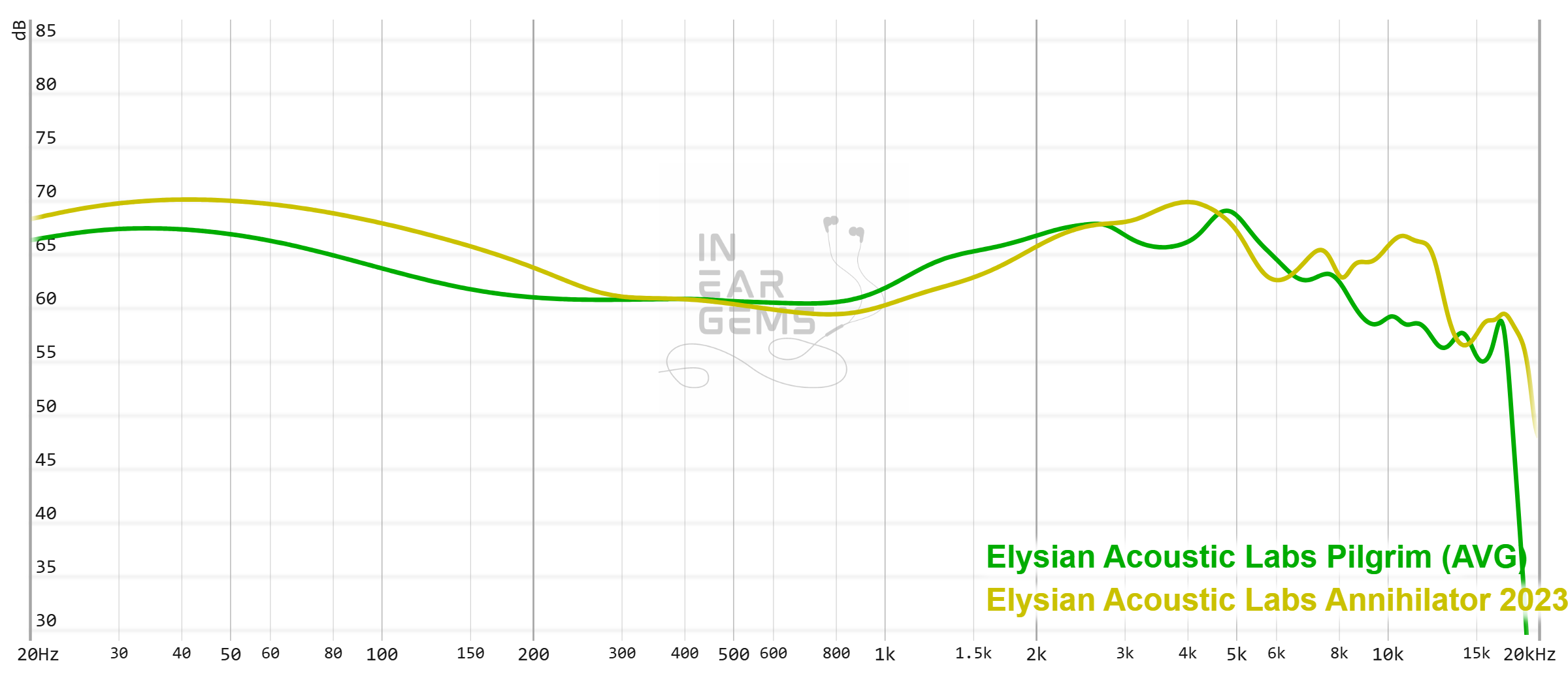
Vs Annihilator 2023: Annihilator 2023 (Anni 2023) is a “tri-brid” flagship of Elysian (if we don’t count the shadowy and exclusive “Dio” prototypes that are pretty much folklore for average joes like myself). In fact, when we think of Elysian, many of us immediately think of Annihilator. Some of us enthusiastically predicted that Pilgrim would be the “baby Annihilator.” Is there any truth in this prediction?
Not really. Firstly, these IEMs are tuned differently. While Pilgrim is mostly neutral IEM, Anni 2023 is a V-shaped hype machine. Stronger midbass and more treble energy across the entire frequency range make Anni 2023 noticeably more punchy and exciting than Pilgrim. Anni 2023 is head-banging when the beat drops, whilst Pilgrim is … alright. Regarding the resolution, whilst Pilgrim is a resolving IEM, as demonstrated in the previous comparisons, it is noticeably less detailed in AB tests against the Anni 2023. For instance, after listening to the choral section with Anni 2023, I was surprised to find how mushy, less separated, and less detailed the choral section is rendered by Pilgrim. The same situation applies to every other instrument and the subtle reverberation in the track.
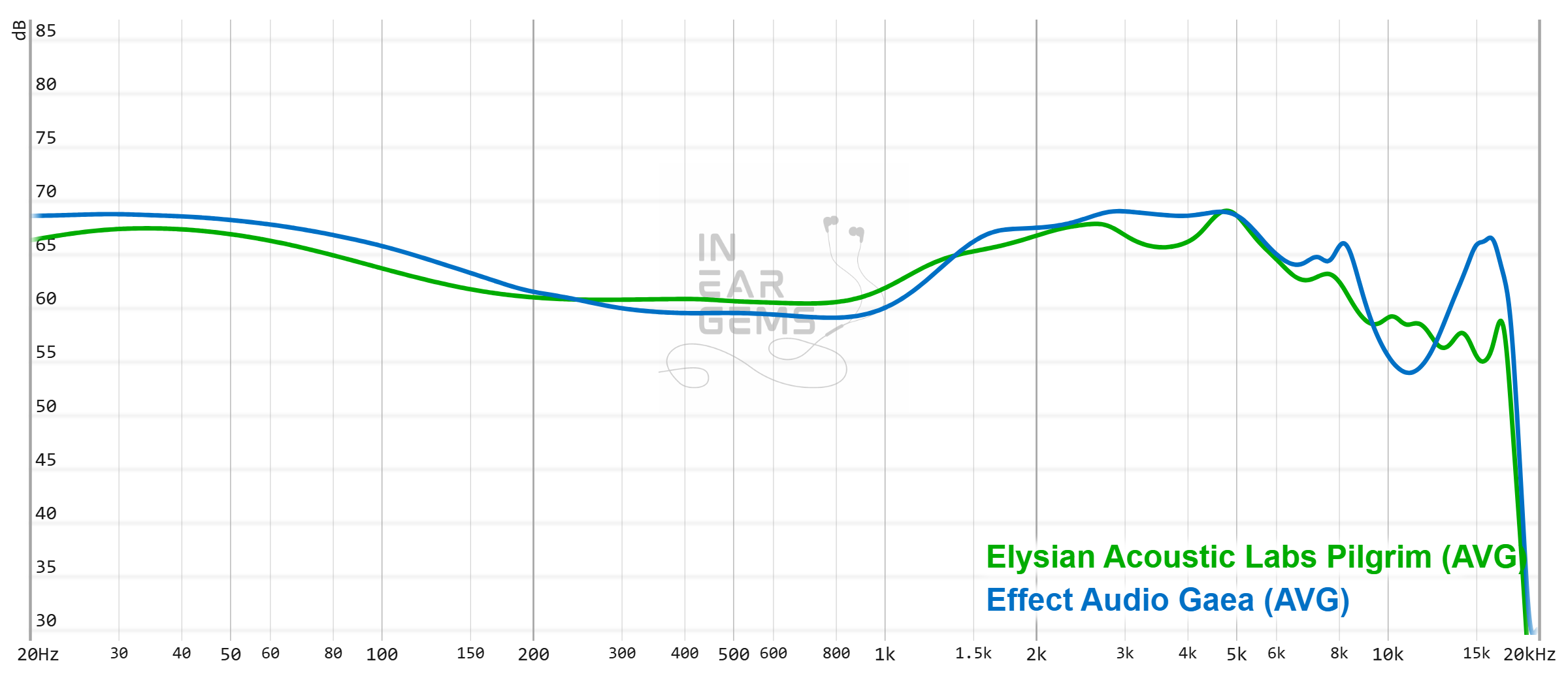
Vs Effect Audio x Elysian Gaea: Gaea is a divisive IEM. Similarly to Anni 2023, it is a V-shaped hype machine that can be too intense for some listeners and libraries. I like this IEM for larger orchestral pieces, “epic soundtracks”, or an energy boost. So, how does the Pilgrim compare against the Gaea?
First, Pilgrim is obviously less energetic and dynamic than Gaea. On the other hand, vocals on Pilgrim are always spot on, while some voices can be quite shrill and strident with Gaea. Regarding resolution, Gaea is half to one step ahead, regardless of how I view it. The stage of Gaea also sounds more 3D, translating to a more immersive experience for the type of music I pair the Gaea with. Your music library and your taste would determine the choice between these IEMs.
Conclusions
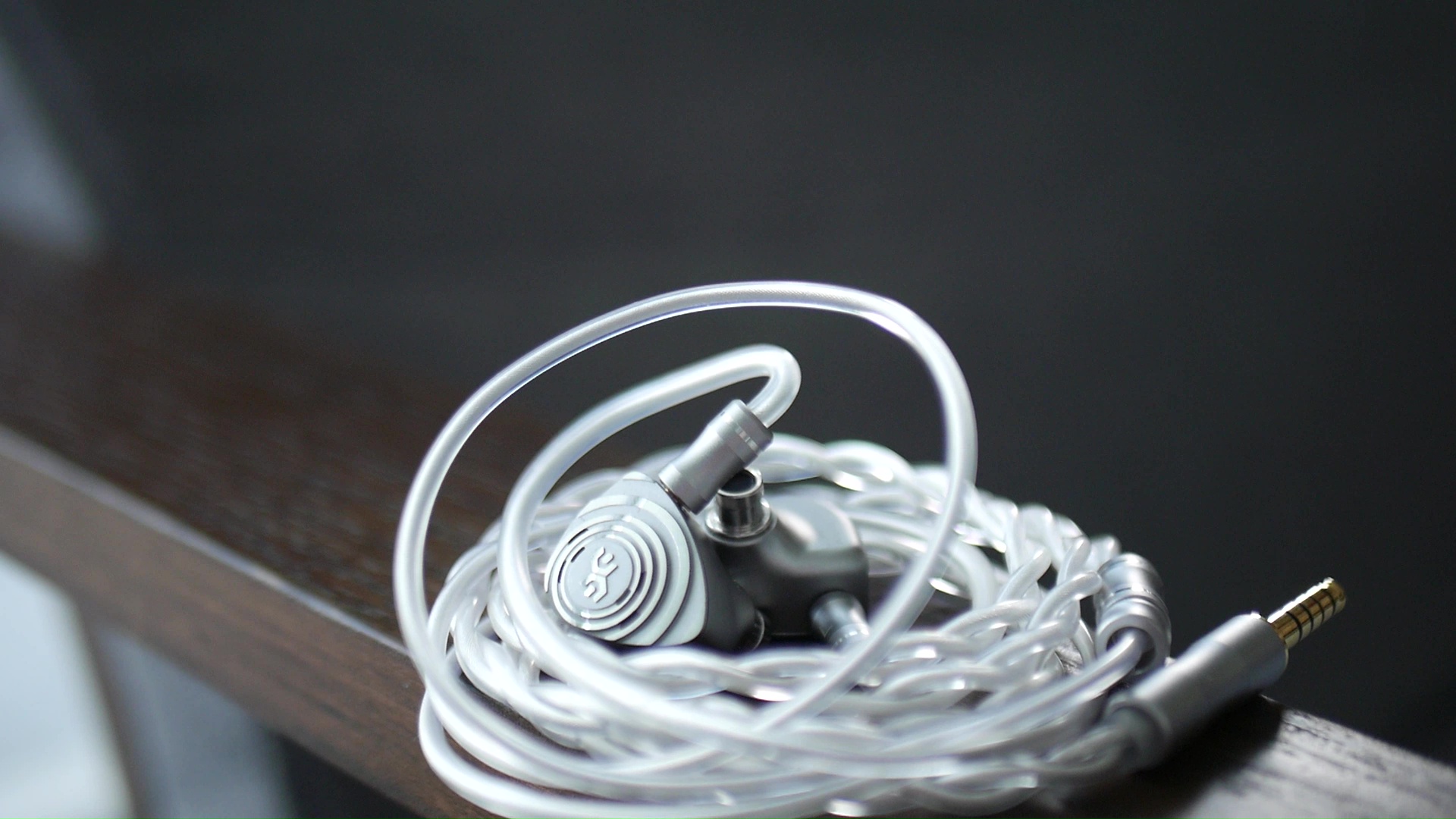
Elysian Acoustic Labs emerged swinging in the “mid-fi” market with the Pilgrim. No, it is not the fabled “baby Annihilator” that some of us have hoped for before the release. Yet, Pilgrim carries the torch of its forebearer, the DIVA and Annihilator, with excellent treble extension, bass extension, and a natural tonal balance that elevates vocal music. The theatric flairs in packaging and accessories of DIVA and Annihilator are also preserved as much as the budget allows. The tuning, technical performance, build quality, and overall packaging make Pilgrim an all-rounder and compelling IEM and, in my opinion, a worthy addition to the Elysian Acoustic Labs family.
Should you get Pilgrim? As always, the answer is “it depends.” If you prefer your music to be rich, warm, and “analogue,” this IEM is not a good choice. If you want an exaggerated, big, bold, even mushy/bleedy bass response, this IEM is also not a good choice. If you wish for an enveloping and engaging soundstage, this IEM might not be the one. But if you want a snappy, clean, clear, neutral presentation with excellent vocal reproduction, if you want clarity and details, Pilgrim receives a recommendation from this reviewer.
What I like about this IEM:
- Neutral tonality with highlighted midrange
- Clarity and detail
- Snappy transient response
- Bass quality and extension
- Precise stereo imaging
- Beautiful design and build quality
What could be improved:
- Flat, unengaging soundstage
- I wish this IEM is even more dynamic and explosive
Absolute Sonic Quality Rating: 5/5 - Outstanding
Bias Score: 4/5 - I like this IEM
